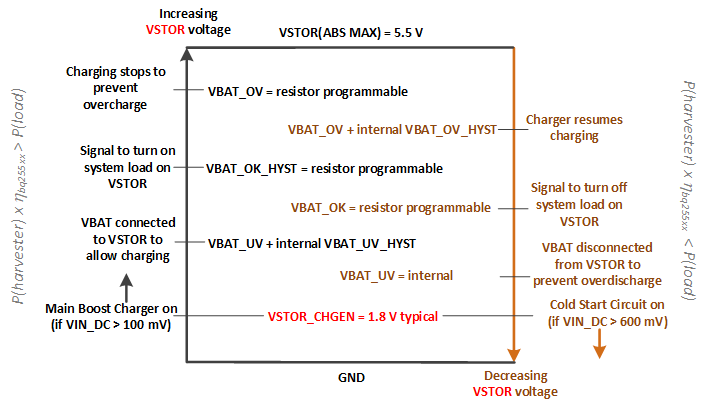SLUSBH2G March 2013 – March 2019
PRODUCTION DATA.
- 1 Features
- 2 Applications
- 3 Description
- 4 Revision History
- 5 Pin Configuration and Functions
- 6 Specifications
-
7 Detailed Description
- 7.1 Overview
- 7.2 Functional Block Diagram
- 7.3
Feature Description
- 7.3.1 Maximum Power Point Tracking
- 7.3.2 Battery Undervoltage Protection
- 7.3.3 Battery Overvoltage Protection
- 7.3.4 Battery Voltage within Operating Range (VBAT_OK Output)
- 7.3.5 Storage Element / Battery Management
- 7.3.6 Programming OUT Regulation Voltage
- 7.3.7 Step Down (Buck) Converter
- 7.3.8 Nano-Power Management and Efficiency
- 7.4 Device Functional Modes
- 8 Application and Implementation
- 9 Power Supply Recommendations
- 10Layout
- 11Device and Documentation Support
- 12Mechanical, Packaging, and Orderable Information
Package Options
Mechanical Data (Package|Pins)
- RGR|20
Thermal pad, mechanical data (Package|Pins)
- RGR|20
Orderable Information
7.3.5 Storage Element / Battery Management
In this section the battery management functionality of the bq25570 integrated circuit (IC) is presented. The IC has internal circuitry to manage the voltage across the storage element and to optimize the charging of the storage element. For successfully extracting energy from the source, two different threshold voltages must be programmed using external resistors, namely battery good threshold (VBAT_OK) and over voltage (OV) threshold. The two user programmable threshold voltages and the internally set undervoltage threshold determine the IC's region of operation. Figure 21 shows the relative position of the various threshold voltages.
